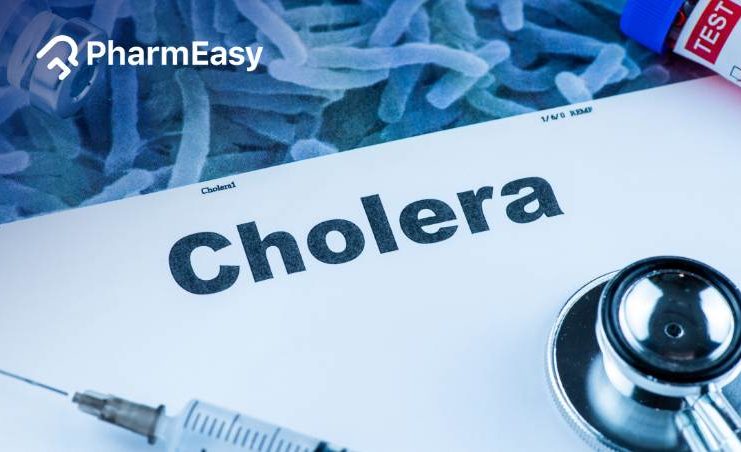Cholera – Symptoms and Causes
By Dr. Mayuri Pandey +2 more

Get,

to manage your symptom
Get your,


4 Cr+ families
benefitted

OTP sent to 9988776655



You’ve successfully subscribed to receive
doctor-approved tips on
Whatsapp

Get ready to feel your best.

Hi There,
Download the PharmEasy App now!!


Register to Avail the Offer
Send OTPBy continuing, you agree with our Privacy Policy and Terms and Conditions

Hi There,
Sign up on PharmEasy now!!
Trusted by 4 crore+ families

OTP sent to 9988776655



You have unlocked 25% off on medicines




Code: NU25
By Dr. Mayuri Pandey +2 more
Table of Contents
This article delves into the world of cholera, an abrupt illness caused by consuming contaminated food or water harbouring Vibrio cholerae bacteria. Harmful organisms in the small intestine produce a toxin called choleragen that sticks to the intestine. This toxin triggers the release of a substance that leads to a significant release of electrolytes and water.2 This faeco-oral transmitted disease triggers severe diarrhoea and dehydration, and can even be fatal. Join us as we explore the impact of this bacterial infection, often affecting regions lacking modern sanitation and clean water system.1 Undeveloped nations and refugee camps, in addition to parts of the Middle East, Asia, South America, and Africa are some examples.1

Out of 10 infected people, 1 person will develop severe symptoms that are listed below:3
When there is a case of profuse water-like diarrhoea, then additional signs are examined in such individuals:
A person who has developed profuse diarrhoea implies that the amount of an infectious agent called Vibrio cholerae has reached greater numbers inside the patient’s body. This has the potential to infect others.3
It is observed that after consumption of contaminated food, a person takes 12 hours to even upto 5 days to develop severe symptoms.
Therefore, anyone who experiences any of the above-mentioned symptoms should immediately visit the doctor. Some early symptoms might fade within a few days. Early diagnosis and onset of administering medications can prevent a patient’s life.1
You may have come across news pieces that in the rural areas of economically poor countries, cholera is a common disease. The reason for this may be the lack of proper water sanitation, compromised sewage disposal and hygiene issues. In such places, the food and water are usually infected with Vibrio cholerae bacteria, consumption of which leads to diarrhoea and other symptoms. They typically take 2–3 days to manifest.
Dr. Siddharth Gupta, B.A.M.S, M.D (Ayu)
The main causative agent of cholera is Vibrio cholerae (V. cholerae) bacteria, which is responsible for the infection and its transmission through contaminated water and food sources.
Vibrio cholerae bacteria, being the causal microbe for cholera, are transferred from infected to healthy individuals through their faeces. V. cholerae grows within people when they consume food, water, or both that is infected with the bacteria. The small intestines then may release fluid as a result of the bacteria, which results in diarrhoea.
Dr. Rajeev Singh, BAMS
Exploring the factors that increase susceptibility to cholera:
After examining the patient for several signs and symptoms, a confirmatory test is required to declare and outline the degree of cholera infection.
When someone contracts cholera their focus should be on preventing dehydration. Since the body fluids are constantly being lost, the water intake must compensate for the loss.
Bacteria causing cholera are not contagious, however, preventive measures can be undertaken to avoid contracting the infection from another person.1
There are 5 fundamental cholera preventive steps as per Centres for Disease Control and Prevention (CDC)8:
Cholera can cause excessive diarrhoea and vomiting, resulting in the loss of important substances in the body.
Insufficient levels of these substances can lead to dehydration and various symptoms:
If left untreated, severe dehydration caused by cholera can lead to serious complications:
Disclaimer: The information included on this site is for educational purposes only and is not intended to be a substitute for medical treatment by a healthcare professional. Because of unique individual needs, the reader should consult their physician to determine the appropriateness of the information for the reader’s situation.
There are no specific animal hosts for Vibrio cholerae bacteria. 4
There is one vaccine for cholera which has been approved by FDA. 1
There are many serogroups of V. cholerae, however, two types – O1 and O139 – are the reasons for cholera outbreaks. 9
During the 19th century, cholera unfolded across the world from its unique reservoir inside the Ganges delta in India.9
Vibrio cholerae bacteria infects the intestine and causes diarrhoea.3
1. Cholera: Symptoms, Causes, Treatment & Prevention [Internet]. Available from: https://my.clevelandclinic.org/health/diseases/16636-cholera
2. Cholera, Vibrio cholerae O1 and O139, and Other Pathogenic Vibrios – Medical Microbiology – NCBI Bookshelf [Internet]. Available from: https://www.ncbi.nlm.nih.gov/books/NBK8407/
3. Cholera [Internet]. Available from: https://www.who.int/news-room/fact-sheets/detail/cholera
Disclaimer: The information provided here is for educational/awareness purposes only and is not intended to be a substitute for medical treatment by a healthcare professional and should not be relied upon to diagnose or treat any medical condition. The reader should consult a registered medical practitioner to determine the appropriateness of the information and before consuming any medication. PharmEasy does not provide any guarantee or warranty (express or implied) regarding the accuracy, adequacy, completeness, legality, reliability or usefulness of the information; and disclaims any liability arising thereof.
Links and product recommendations in the information provided here are advertisements of third-party products available on the website. PharmEasy does not make any representation on the accuracy or suitability of such products/services. Advertisements do not influence the editorial decisions or content. The information in this blog is subject to change without notice. The authors and administrators reserve the right to modify, add, or remove content without notification. It is your responsibility to review this disclaimer regularly for any changes.

Leave your comment...
Comments